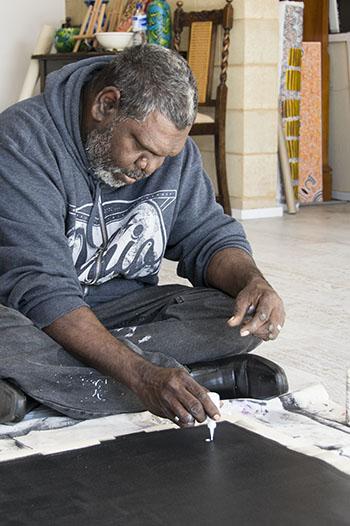Telling stories through painting
Duration/age

There are many ways to tell a story, not only by reading a book. Many cultures share and tell their stories through painting. The colour, symbols, design and patterns included in a painting will tell you a story about that person and what is important to them.
The painting can tell you the story of where a person lives, what animals or food can be found there and who they are connected to. The symbols in the painting can even tell you the age and status of the person.
Next time you are out and about, you and your child could visit an Aboriginal gallery. Sometimes Aboriginal galleries have a visiting artist that you can watch paint and talk to them about what they are doing.
Can you and your child work out what the story is by looking at the colour, design and symbols used? Show your child that galleries have captions on the wall to explain what the painting is about.
This painting is a Dreaming story from central Australia. The story is about how the waterholes and the rivers were made.
Materials you will need
- Images of paintings
Alternative tools
- An art gallery
- Books with pictures of paintings
- Public art displays
- Murals
Skills this activity improves
Why does this matter?
Exploring the messages and meanings created within the painting helps your child to understand that stories can be told in different ways.
As you explore the designs, symbols and colours of different paintings your child will be developing their language and observational skills. They will begin to understand that symbols and pictures convey a message, and that how they are organised on the canvas can change their meaning.
Talking about how the painting has been designed and where the artist started helps your child to develop planning and organisational skills. As you talk about where the artist started and the order the design was created in, your child is learning that events happen in a sequence and there is a pattern to the sequence.
'They do the background of the painting first then they put the large symbol on next. The small details around the symbols are added last.'
What does this lead to?
As your child grows older, understanding the different ways language can be presented will help them to make decisions on how to organise or record their thinking. Exploring the stories recorded within paintings helps them to develop rich oral language and to use this in their general conversations with others.
Sharing traditional and important stories from your own culture and family helps your child to develop a strong cultural identity. The sharing of family and cultural stories helps to keep the stories alive and to pass on important information about the family, behaviours and traditions that are often not written down.
Talking together about what you have noticed within the painting helps your child to ask questions. As they notice objects they can group them and compare the differences. As they talk about what they notice they are developing language to describe their thinking and observations.
Describing the process the artist has used to develop the story of the painting helps children to develop planning skills, positional language and to develop the language to explain their own thinking.
Language to use
- Painting
- Image, symbol, picture, pattern
- Start, beginning, middle, end, during
- Story, design, symbolism
- Colour, shade, depth, light, dark
- Small, medium, large
- Paper, canvas, bark
- Paint, brush, dye, roller
Questions to use
- Where would you start?
- Which detail would you do last?
- Do all paintings use different colours?
- Do all paintings have pictures?
- What can you use to make dots?
- Are all paintings made with a brush?
Useful tips
- You might also like to take a look at the activities Visiting the art gallery and Fabric of life.
- Remember to talk to your child in your home language.
More ideas
- Visit the Art Gallery of South Australia and the South Australian Museum.
- Borrow art books from your local library about Aboriginal art and symbols.
- Visit Tandanya Art Gallery to talk to the resident artist.
Variation by age
Three to five year olds
- Make a sand tray and practise drawing your own symbols in the sand.
- Write your own family story. Create a painting that represents your story.
- Visit the Yuendumu School Doors at the South Australian Museum. Can you find the different symbols painted on the doors?
- Find public art displays around your neighbourhood.
- Draw different symbols and pictures in shaving cream.
Questions to ask
- Do all pieces of art tell a story?
- Do all people get the same message when they look at a painting?
- What is the difference between public and private art?
- Can you find art outside of a gallery?
Language to use
- Gallery, public space, private collection, on loan, display
- Symbol, picture
- Modern, contemporary, abstract, portrait, landscape
- Colour, depth, shade


